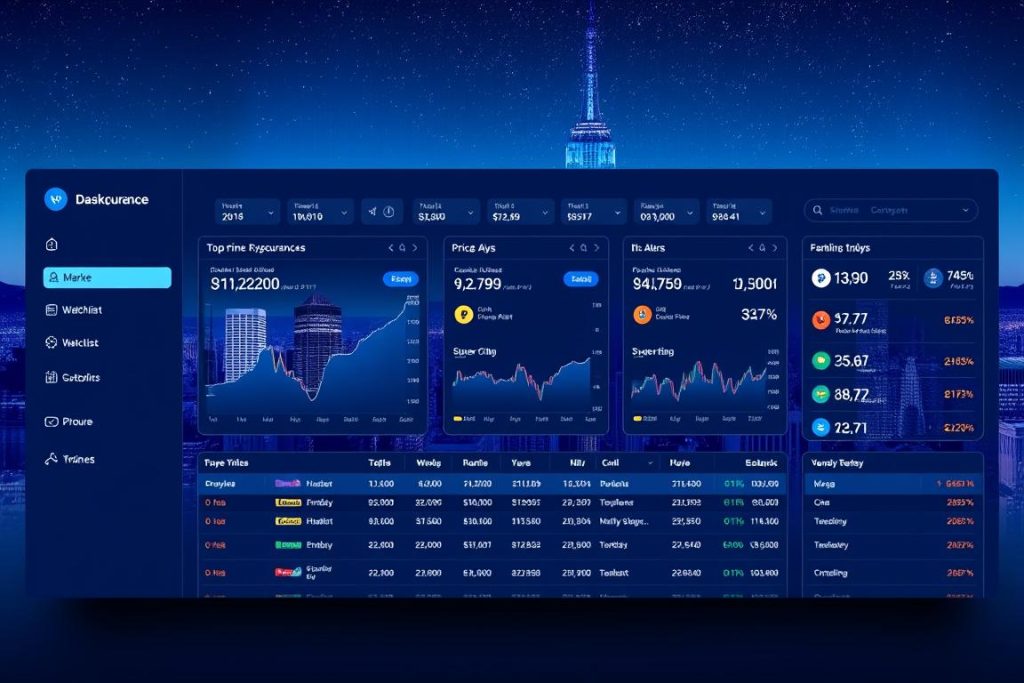The cryptocurrency market has seen a significant surge, with the global market capitalization reaching $2.5 trillion in recent times. This growth has sparked interest in understanding the dynamics of cryptocurrency pricing.
As investors and enthusiasts alike seek to navigate this complex landscape, identifying the top cryptocurrencies by their market value becomes crucial. This article aims to provide insights into the current market, highlighting the leading cryptocurrencies and what drives their value.
Key Takeaways
- Understanding the current market capitalization of cryptocurrencies.
- Identifying the top cryptocurrencies based on their market value.
- Exploring the factors that influence cryptocurrency pricing.
- Gaining insights into the dynamics of the cryptocurrency market.
- Learning how to navigate the complex cryptocurrency landscape.
Understanding Cryptocurrency Pricing
Cryptocurrency prices are determined by a multitude of factors. Understanding these factors is crucial for investors looking to navigate the complex world of digital currencies.
What Determines a Cryptocurrency’s Price
A cryptocurrency’s price is influenced by its utility, adoption rate, and market sentiment. The more useful and widely adopted a cryptocurrency is, the higher its price tends to be.
Market Capitalization vs. Price
It’s essential to differentiate between market capitalization and price. Market capitalization is the total value of all coins in circulation, while price refers to the cost of a single unit. A high market capitalization doesn’t always mean a high price per coin.
Price Volatility in Crypto Markets
Cryptocurrency markets are known for their volatility. Price fluctuations can be significant, driven by various factors including news, regulatory changes, and market speculation.
Short-term vs. Long-term Price Movements
Investors should distinguish between short-term price movements, which can be highly volatile, and long-term trends, which may provide a more stable outlook. Key factors include:
- Market news and events
- Regulatory announcements
- Technological advancements
Top Cryptocurrencies by Price in 2023
As we dive into 2023, the top cryptocurrencies by price reveal a fascinating landscape. The cryptocurrency market is known for its volatility, but certain coins have consistently held high value.
Bitcoin (BTC): The Gold Standard
Bitcoin remains the leading cryptocurrency by price, often considered the gold standard of the crypto world. Its price history is marked by significant milestones.
Bitcoin Price History and Milestones
Bitcoin’s price has seen tremendous growth since its inception. Notable milestones include its first major price surge in 2013 and its all-time high in 2021.
- Initial price surge in 2013
- All-time high in 2021
- Consistent market dominance
Ethereum (ETH): The Leading Altcoin
Ethereum is the second-largest cryptocurrency by market capitalization and has been a strong contender in the crypto market. Its price has been influenced by the growth of DeFi and NFT markets.

Binance Coin (BNB): Exchange Token Leader
Binance Coin, the native cryptocurrency of the Binance exchange, has seen significant price growth due to its utility within the Binance ecosystem.
Other High-Value Cryptocurrencies
Apart from Bitcoin and Ethereum, other cryptocurrencies have gained significant value.
Solana, Cardano, and Polkadot
Solana (SOL), Cardano (ADA), and Polkadot (DOT) are among the high-value cryptocurrencies. They have gained attention for their technological advancements and market potential.
- Solana (SOL) for its fast transaction speeds
- Cardano (ADA) for its focus on peer-reviewed research
- Polkadot (DOT) for its interoperability features
The list of top cryptocurrencies by price in 2023 highlights the diversity and complexity of the crypto market. Understanding these key players is essential for navigating the market.
Factors Influencing Cryptocurrency Prices
Understanding the factors that influence cryptocurrency prices is crucial for investors looking to navigate the volatile crypto market. Several key elements play a significant role in determining the prices of cryptocurrencies.
Supply and Demand Dynamics
The balance between the supply of a cryptocurrency and the demand for it significantly affects its price. When demand is high and supply is limited, prices tend to rise. Conversely, if supply exceeds demand, prices may fall.
Market Sentiment and News
Market sentiment, influenced by news and events, can drastically impact cryptocurrency prices. Positive news can lead to increased demand and higher prices, while negative news can cause prices to drop.
Technological Developments
Advancements in blockchain technology and the development of new features can impact the price of a cryptocurrency. Improvements that enhance usability, security, or scalability can increase a cryptocurrency’s value.
Regulatory Announcements
How Government Policies Affect Crypto Prices
Government policies and regulatory announcements can have a significant impact on cryptocurrency prices. Regulations that are perceived as favorable can boost prices, while restrictive regulations can lead to price declines.
| Factor | Impact on Price | Examples |
|---|---|---|
| Supply and Demand | High demand and low supply increase price | Bitcoin halving events |
| Market Sentiment | Positive sentiment increases price | Elon Musk’s tweets about Dogecoin |
| Technological Developments | Improvements increase price | Ethereum’s transition to Proof of Stake |
| Regulatory Announcements | Favorable regulations boost price | Countries adopting crypto-friendly laws |

Cryptocurrency prices are influenced by a complex interplay of factors. Understanding these elements can help investors make more informed decisions when navigating the crypto market.
Comparing Cryptocurrencies by Price
Understanding how to compare cryptocurrencies by price is crucial for making informed investment decisions. With numerous cryptocurrencies available, comparing their prices can help investors identify potential opportunities and risks.
Price-to-Utility Ratio
The price-to-utility ratio is a critical metric for evaluating cryptocurrencies. It involves assessing the price of a cryptocurrency in relation to its utility, use cases, and overall value proposition. A cryptocurrency with a high utility but low price might be considered undervalued, presenting a potential investment opportunity.
Relative Price Performance
Analyzing the relative price performance of different cryptocurrencies can provide insights into their market trends and investor preferences. By comparing the price movements of various cryptocurrencies, investors can identify which ones are outperforming or underperforming the market.

Price Correlation Between Coins
The price correlation between different cryptocurrencies is another important aspect to consider. Some cryptocurrencies may have a high positive correlation, meaning their prices tend to move together, while others may have a negative correlation, indicating that their prices move in opposite directions.
Bitcoin Dominance and Altcoin Prices
Bitcoin’s dominance in the cryptocurrency market can significantly influence the prices of altcoins. When Bitcoin’s price surges, it can lead to a decrease in altcoin prices due to reduced investor interest. Conversely, a decline in Bitcoin’s dominance can result in increased altcoin prices as investors seek alternative investment opportunities.
By understanding these dynamics, investors can make more informed decisions when comparing cryptocurrencies by price, ultimately helping them to navigate the complex cryptocurrency market more effectively.
How to Track Cryptocurrencies by Price
The cryptocurrency market is known for its rapid price fluctuations, making it essential to have reliable price tracking methods. Investors and traders alike need to stay informed about the latest prices to make timely decisions.
Popular Cryptocurrency Price Tracking Websites
Several websites provide real-time cryptocurrency price tracking. These platforms offer comprehensive data on various cryptocurrencies, helping investors stay updated.
CoinMarketCap, CoinGecko, and TradingView
- CoinMarketCap: Known for its detailed market capitalization data and real-time price updates.
- CoinGecko: Offers a wide range of data, including price charts and market trends.
- TradingView: Provides advanced charting tools and technical analysis features.

Mobile Apps for Price Alerts
Mobile apps offer the convenience of tracking cryptocurrency prices on-the-go. Apps like Blockfolio and Delta provide real-time price alerts and portfolio management.
Setting Up Price Notifications
Setting up price notifications is crucial for staying informed about significant price movements. Most tracking platforms and apps allow users to customize alerts based on specific price thresholds.
Live Price Feeds and API Access
For developers and advanced users, live price feeds and API access provide a way to integrate real-time cryptocurrency data into their applications. This enables the creation of custom tracking tools and automated trading systems.
By utilizing these methods, investors can stay ahead in the cryptocurrency market, making informed decisions based on real-time data.
Step-by-Step Guide to Analyzing Cryptocurrency Prices
Understanding the intricacies of cryptocurrency pricing is crucial for making informed investment decisions. The process involves several key steps that help investors navigate the complex and often volatile cryptocurrency market.
Step 1: Understand Basic Price Charts
Price charts are the foundation of cryptocurrency analysis. They provide a visual representation of a cryptocurrency’s price over time.
Candlestick Patterns and What They Mean
Candlestick patterns are a crucial aspect of price chart analysis. They can indicate trends, reversals, and market sentiment.
- Bullish Patterns: Indicate potential price increases.
- Bearish Patterns: Suggest potential price decreases.
Step 2: Identify Key Price Indicators
Key price indicators, such as Moving Averages and Relative Strength Index (RSI), help investors understand market trends and potential future movements.
| Indicator | Description | Use Case |
|---|---|---|
| Moving Average | Averages price over a set period | Identifies trends |
| RSI | Measures price change velocity | Identifies overbought/oversold conditions |
Step 3: Compare Historical Price Data
Comparing historical price data helps investors understand how a cryptocurrency has performed under various market conditions.
“Historical data is crucial for understanding the potential future performance of a cryptocurrency.”
Step 4: Evaluate Price in Relation to News Events
News events can significantly impact cryptocurrency prices. Evaluating price movements in relation to news helps investors make informed decisions.
Step 5: Make Informed Decisions Based on Price Analysis
By following these steps, investors can make informed decisions based on thorough price analysis, rather than relying on speculation or emotions.
Investment Strategies Based on Cryptocurrency Prices
Cryptocurrency prices can be unpredictable, making it crucial for investors to adopt well-informed investment strategies. The volatile nature of the crypto market demands a thoughtful approach to investing.
Dollar-Cost Averaging
Dollar-cost averaging is a strategy that involves investing a fixed amount of money at regular intervals, regardless of the cryptocurrency’s current price. This approach helps reduce the impact of volatility and timing risks.
Buy and Hold (HODL)
The “buy and hold” or HODL strategy involves purchasing a cryptocurrency and holding onto it for an extended period, regardless of short-term price fluctuations. This strategy is based on the belief that the cryptocurrency’s value will increase over time.
Trading Based on Price Movements
Trading based on price movements involves actively buying and selling cryptocurrencies based on their current and predicted price trends. This strategy requires a deep understanding of market analysis and timing.
Day Trading vs. Swing Trading
Day trading involves making multiple trades within a single day, taking advantage of short-term price movements. Swing trading, on the other hand, involves holding positions for a shorter period than investing, but longer than a day, typically ranging from a few days to a few weeks.
Portfolio Diversification Strategies
Portfolio diversification is a risk management strategy that involves spreading investments across different cryptocurrencies. This can help mitigate potential losses by ensuring that not all investments are subject to the same market fluctuations.
| Strategy | Description | Risk Level |
|---|---|---|
| Dollar-Cost Averaging | Investing a fixed amount regularly | Low |
| Buy and Hold | Holding cryptocurrency long-term | Medium |
| Trading Based on Price Movements | Buying and selling based on price trends | High |
Low-Priced Cryptocurrencies with High Potential
Low-priced cryptocurrencies, often referred to as ‘cheap coins,’ can be an attractive option for investors looking for high potential returns. These cryptocurrencies are typically under $1 and have garnered significant attention in the crypto community.
Emerging Altcoins Under $1
Several emerging altcoins are currently priced under $1, offering investors an opportunity to buy in at a lower cost. Some of these altcoins have shown promising signs, such as innovative technology or strategic partnerships.
Evaluating Low-Price, High-Potential Projects
When evaluating low-price, high-potential projects, investors should consider several key factors, including the project’s whitepaper, the team behind it, and its market potential. A thorough analysis can help mitigate risks and identify promising opportunities.
Risk Assessment for Low-Priced Coins
Investing in low-priced coins comes with inherent risks, including market volatility and the potential for scams. It’s crucial for investors to conduct their own research and due diligence.
Avoiding Pump and Dump Schemes
Pump and dump schemes are a significant risk in the low-priced cryptocurrency market. Investors should be cautious of coins that experience sudden, unexplained price surges. Verifying the legitimacy of a project and being wary of overly promotional material can help investors avoid these schemes.
By being informed and cautious, investors can navigate the complex landscape of low-priced cryptocurrencies and potentially capitalize on high-growth opportunities.
Tools and Platforms for Cryptocurrency Price Analysis
To stay ahead in the cryptocurrency market, investors use advanced tools and platforms for price analysis. These resources enable traders to make informed decisions, leveraging data to predict market trends.
Technical Analysis Tools
Technical analysis tools are crucial for understanding market trends and predicting future price movements. Platforms like TradingView and Coinigy offer comprehensive charting tools, indicators, and drawing tools that help traders analyze the market.
Price Prediction Algorithms
Price prediction algorithms use complex mathematical models to forecast cryptocurrency prices. These algorithms analyze historical data, market sentiment, and other factors to predict future trends. Services like CoinPredictor utilize AI and machine learning to provide accurate predictions.
Cryptocurrency Exchanges with Advanced Charts
Many cryptocurrency exchanges now offer advanced charting tools directly on their platforms. Exchanges like Binance and Kraken provide real-time data, various chart types, and technical indicators, making it easier for traders to analyze prices without leaving the exchange.
Price Alert Services and Bots
Price alert services and trading bots automate the process of monitoring cryptocurrency prices. Tools like CryptoHopper and 3Commas allow users to set custom alerts and execute trades based on predefined conditions, ensuring that traders never miss a market opportunity.
By leveraging these tools and platforms, cryptocurrency investors can enhance their trading strategies, making more informed decisions in the volatile cryptocurrency market.
Managing Risk When Investing Based on Price
The volatile nature of cryptocurrency prices necessitates a robust risk management strategy. Investors must be prepared for significant price swings, which can result in substantial gains or losses.
Setting Stop-Loss Orders
A crucial risk management tool is the stop-loss order, which automatically sells a cryptocurrency when its price falls to a predetermined level. This helps limit potential losses if the market moves against the investor.
Position Sizing Based on Price Volatility
Investors should also consider position sizing to manage risk. By adjusting the amount invested in a particular cryptocurrency based on its volatility, investors can mitigate potential downsides.
Hedging Strategies in Volatile Markets
Hedging involves taking positions in multiple assets to offset potential losses. In cryptocurrency markets, this might involve diversifying across different coins or using derivatives.
Psychological Aspects of Price-Based Investing
The psychological impact of price movements should not be underestimated. Fear and greed can drive investment decisions, often to the detriment of the investor. Maintaining a disciplined approach is crucial.
| Risk Management Strategy | Description | Benefit |
|---|---|---|
| Stop-Loss Orders | Automatic sale of cryptocurrency at a set price | Limits potential losses |
| Position Sizing | Adjusting investment amount based on volatility | Mitigates downside risk |
| Hedging | Diversifying investments to offset losses | Reduces overall risk |
Conclusion: Mastering Cryptocurrency Investment Through Price Analysis
Understanding the intricacies of cryptocurrency pricing is crucial for making informed investment decisions. By analyzing criptomoedas por preço, investors can gain insights into market trends and potential future movements.
Effective análise de preços de criptomoedas involves evaluating various factors, including market sentiment, technological developments, and regulatory announcements. This comprehensive approach enables investors to navigate the complex cryptocurrency market with confidence.
By mastering the skills outlined in this article, investors can develop a robust investment strategy tailored to their needs and risk tolerance. Staying informed about market dynamics and continually refining one’s analysis skills are key to success in the ever-evolving world of cryptocurrency investment.
FAQ
What determines the price of a cryptocurrency?
How do I track cryptocurrency prices in real-time?
What is the difference between market capitalization and price?
How do I compare the prices of different cryptocurrencies?
What are some investment strategies based on cryptocurrency prices?
How can I manage risk when investing in cryptocurrencies based on their prices?
What are some tools and platforms for cryptocurrency price analysis?
How do I evaluate low-priced cryptocurrencies with high potential?
What determines the price of a cryptocurrency?
How do I track cryptocurrency prices in real-time?
What is the difference between market capitalization and price?
How do I compare the prices of different cryptocurrencies?
What are some investment strategies based on cryptocurrency prices?
How can I manage risk when investing in cryptocurrencies based on their prices?
What are some tools and platforms for cryptocurrency price analysis?
How do I evaluate low-priced cryptocurrencies with high potential?
FAQ
What determines the price of a cryptocurrency?
The price of a cryptocurrency is determined by various factors, including supply and demand dynamics, market sentiment, news, technological developments, and regulatory announcements.
How do I track cryptocurrency prices in real-time?
You can track cryptocurrency prices in real-time using popular price tracking websites like CoinMarketCap, CoinGecko, and TradingView, as well as mobile apps that provide price alerts and live price feeds.
What is the difference between market capitalization and price?
Market capitalization refers to the total value of all outstanding coins or tokens of a particular cryptocurrency, while price refers to the current value of a single unit of that cryptocurrency.
How do I compare the prices of different cryptocurrencies?
You can compare the prices of different cryptocurrencies by looking at their relative price performance, price-to-utility ratio, and price correlation with other coins, as well as considering factors like Bitcoin dominance and altcoin prices.
What are some investment strategies based on cryptocurrency prices?
Some popular investment strategies based on cryptocurrency prices include dollar-cost averaging, buy and hold (HODL), trading based on price movements, and portfolio diversification strategies.
How can I manage risk when investing in cryptocurrencies based on their prices?
To manage risk, you can set stop-loss orders, size your positions based on price volatility, use hedging strategies in volatile markets, and be aware of the psychological aspects of price-based investing.
What are some tools and platforms for cryptocurrency price analysis?
Some popular tools and platforms for cryptocurrency price analysis include technical analysis tools, price prediction algorithms, cryptocurrency exchanges with advanced charts, and price alert services and bots.
How do I evaluate low-priced cryptocurrencies with high potential?
To evaluate low-priced cryptocurrencies with high potential, you should research emerging altcoins under
FAQ
What determines the price of a cryptocurrency?
The price of a cryptocurrency is determined by various factors, including supply and demand dynamics, market sentiment, news, technological developments, and regulatory announcements.
How do I track cryptocurrency prices in real-time?
You can track cryptocurrency prices in real-time using popular price tracking websites like CoinMarketCap, CoinGecko, and TradingView, as well as mobile apps that provide price alerts and live price feeds.
What is the difference between market capitalization and price?
Market capitalization refers to the total value of all outstanding coins or tokens of a particular cryptocurrency, while price refers to the current value of a single unit of that cryptocurrency.
How do I compare the prices of different cryptocurrencies?
You can compare the prices of different cryptocurrencies by looking at their relative price performance, price-to-utility ratio, and price correlation with other coins, as well as considering factors like Bitcoin dominance and altcoin prices.
What are some investment strategies based on cryptocurrency prices?
Some popular investment strategies based on cryptocurrency prices include dollar-cost averaging, buy and hold (HODL), trading based on price movements, and portfolio diversification strategies.
How can I manage risk when investing in cryptocurrencies based on their prices?
To manage risk, you can set stop-loss orders, size your positions based on price volatility, use hedging strategies in volatile markets, and be aware of the psychological aspects of price-based investing.
What are some tools and platforms for cryptocurrency price analysis?
Some popular tools and platforms for cryptocurrency price analysis include technical analysis tools, price prediction algorithms, cryptocurrency exchanges with advanced charts, and price alert services and bots.
How do I evaluate low-priced cryptocurrencies with high potential?
To evaluate low-priced cryptocurrencies with high potential, you should research emerging altcoins under $1, assess their potential for growth, and be cautious of risks like pump and dump schemes.
, assess their potential for growth, and be cautious of risks like pump and dump schemes.
